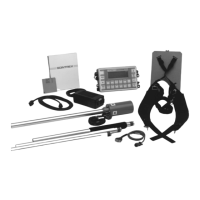pplications
ENVI-MAG Manual B1-1
Chapter
Overview
1
Magnetic surveying overview
Introduction
These application notes review some of the numerous environmental
applications for which the ENVI-MAG is designed. The first chapter will give a
general overview of the purpose and scope of a magnetometer survey. In the
second chapter, we shall discuss the planning of a magnetometer survey carried
out with the ENVI-MAG, Environmental Magnetometer/Gradiometer, within a
specific environmental application. The third and last chapter will be devoted to
applications in the field. These applications will illustrate field results as well as
the corresponding structures or objects creating the magnetic anomalies.
Basic magnetic theory
What is being measured?
In a simple way, the Earth can be described as a large magnet with the north pole
pointing south (that is why the needle on your compass points north because it
is attracted by a magnetic pole of opposite sign). Figure B-1 on page B1-2
illustrates the magnetic field of the Earth. The Earth’s field at any given point on
the Earth is vector, in that it has a preferred orientation (direction) and an
amplitude (intensity). The inclination and declination describe the local
orientation of the Earth’s magnetic field vector.
The orientation and intensity of the Earth’s field is quite well known. The map of
the Earth’s magnetic intensity is shown in Figure B-4 on page B1-4. You will need
to refer to this figure occasionally, in order to set the base-field parameters on the
ENVI-MAG. The magnetic field intensity is usually expressed in gammas or
nanoTeslas. NanoTesla is the preferred SI nomenclature, however, a nT equals a
gamma. The values of the Earth’s magnetic field that you will typically observe
should vary from 25,000 nT to 70,000 nT.

